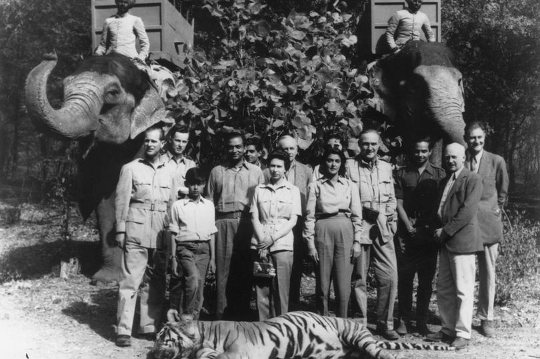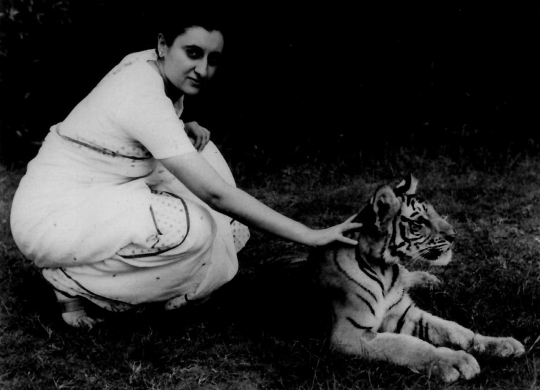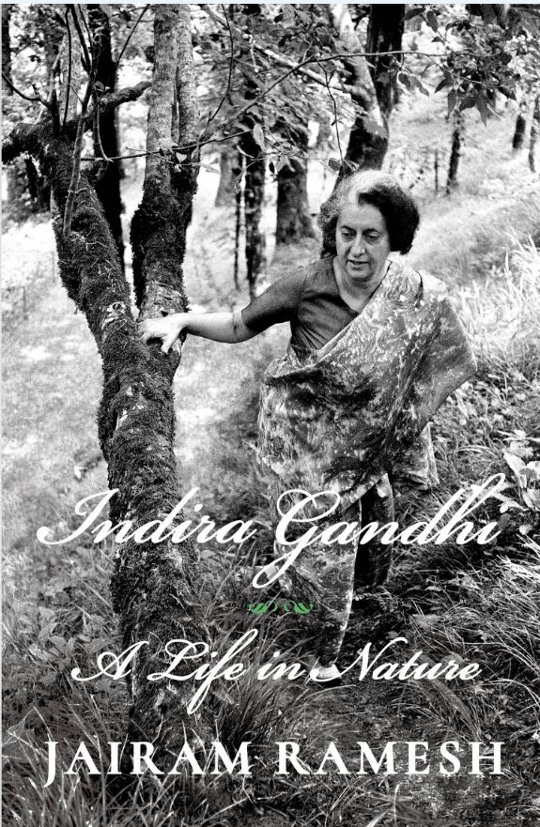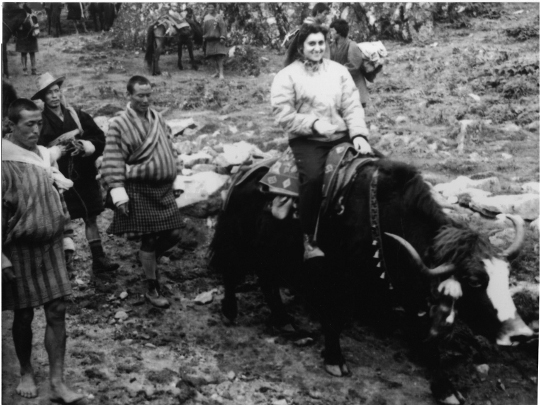Jairam Ramesh, a Congressman and former Environment Minister, has written a highly sympathetic account of Prime Minister Indira Gandhi’s environmentalism, a less-known aspect of her political career, in Indira Gandhi – A Life in Nature (Simon & Schuster Rs 799). This is her hundredth birth anniversary and his tome delves exhaustively into her correspondence, notes on files and other records, all of which lie in the public domain and the author has conducted meticulous research into.
Cover image of the book. Picture: Simon & Schuster
To give the controversial PM her due, she was far ahead of her times on this score. She imbibed her passion for nature from her father. Both often went on trips to the mountains together and Nehru wrote to her even from prison, inculcating in her an indelible love for the wild. When she became Premier herself in 1966, the words “ecology” and “environment” were hardly currency and she did well to give these concepts a niche in political decision-making, overriding short-term economic interests.
One questions, however, whether her concern for the environment was elitist to begin with. This is reflected in the earlier preoccupation with wildlife and the tiger in particular. Much such concern was originally expressed by former maharajas out of self-interest. The royals developed an interest in wildlife because they hunted in their private forests and wanted to ensure that these were sufficiently packed with game.
The World Wildlife Fund (WWF) was founded by Prince Bernhard of the Netherlands, Prince Philip of Britain and others in 1961. It played a major role in Project Tiger here. In 1961 itself, Prince Philip on a visit to India shot an eight-foot-long tiger, a crocodile and six mountain sheep, overriding protests from British and Indian politicians. He posed for a picture with the tiger with the Maharaja and Maharani of Jaipur in Ranthambore.
A letter written to Gandhi by Bernhard, who was chairman of World Wildlife Fund-International, in 1972 states how the organisation was “preparing a major international campaign to raise the equivalent of one million dollars to save the Tiger” and asked whether a WWF Trustee, Guy Mountfort, could meet her.

Prince Philip, Queen Elizabeth, Maharaja and Maharani of Jaipur in Ranthambore. Picture: Simon & Schuster
Mountfort did so and noted in a memo: “Her manner in discussion alternates between feminine charm and masculine decisiveness…She was determined that everything should be done to save the tiger. We had been told that if we could secure per personal interest in Operation Tiger, success would be secured…She said she would form a special ‘task force’ which she would require to report to her personally…To everyone’s astonishment the task force was formed the next morning and it met the following day.”
This gives a good glimpse into Mrs Gandhi’s imperiousness and how environmental issues were often solved by diktat rather than discussion. However, one could argue the converse: given the abysmal ignorance regarding, if not opposition to, protecting wilderness areas – a deplorable tendency which has found full expression in the present BJP governments at the centre and in states – it was necessary to ride roughshod over political objections in those early years of preserving the country’s ecology.
However, the PM was excessively influenced by the need to demonstrate her green credentials to international environmental institutions and individuals, as letter after letter make evident. She noted that Mountfort and WWF Director-General Charles de Haes had mentioned $1 million as its contribution: “While I agree that Project Tiger should essentially be an Indian venture, we should not hesitate to secure as much international assistance as possible.” After the initiative was launched in 1973, Ramesh observes that the WWF contributed just 13 per cent of the project cost in its first phase of six years: “The project was financed overwhelmingly by Indira Gandhi’s government and she was aware that considerable money – almost Rs 6 crores over a six-year period – was being spent for tiger protection – in an era when resources were extremely scarce and competing demands were many.”

Project Tiger was financed by Indira Gandhi's government.
Picture: Simon & Schuster
This was years before Gandhi became paranoid about the “foreign hand” which she thought was omnipresent in destabilising the country across the board. As a product of elite schools in Switzerland and Oxford, and under her patrician father, she was swayed by a wide range of foreign personages who wrote to her, expressing their concern about India’s dwindling wildlife and forests.
This reviewer has documented this predilection in some detail in his 1985 book, Temples or Tombs? Industry vs Environment: Three Controversies (Centre for Science & Environment, New Delhi). The most interesting case in this book was the Silent Valley hydroelectric project in Kerala, which Gandhi was instrumental in scrapping. This was after the International Union for Conservation of Nature (IUCN) and WWF raised the issue in world fora. Although Ramesh lists my book in his references, he doesn’t cite it.
I write:“Whatever her faults of omission and commission, Mrs Gandhi had certainly displayed a greater awareness of environmental problems than other Indian leaders, though I suspect this was often as much because of a shrewd appreciation of her image abroad as genuine commitment. She released the World Conservation Strategy (of the IUCN) in Delhi itself; her exposure to environmental issues had always been oriented towards the West. The very fact that David Munro, the IUCN Director General, felt confident enough to write to her when she returned to power in 1980 to intercede and save Silent Valley speaks for itself. What is more, Mrs Gandhi’s concern was largely aesthetic – in the Nehru tradition of pride in national heritage. In November 1984, the IUCN conferred the John C. Philips medal, its highest honour, on her posthumously.”
As an aside, it should be recorded that Gandhi made the fatal mistake of wanting to prove to the world – the foreign press in particular-- that her national emergency between 1975 and 1977 had popular support. This miscalculation is what prompted her to call for elections in 1977, which booted her out of power. When Project Tiger reported an increase in the number of these big cats during that infamous period, many were sceptical whether this was an exaggerated claim, given press censorship.
As a footnote, though not in any way implicating the PM but only to highlight the danger of hobnobbing with royal conservationists, as we have seen with Prince Philip, the WWF found itself embroiled in the shenanigans of Prince Bernhard. In 2014, the translation of a book by a German titled Pandaleaks – after the WWF’s mascot – reported that in 1970 Bernhard had set up a group of 1,001 influential multinationals to funnel donations to the foundation as an instance of ‘greenwashing’.
As the well-known British environmental journalist John Vidal wrote in the Observer: “By setting up ‘round tables’ of industrialists on strategic commodities such as palm oil, timber, sugar, soy, biofuels and cocoa, WWF International has become a political power that is too close to industry and in danger of becoming reliant on corporate money…Until recently it was widely thought that people and wildlife could not live together, which led to the group being accused of complicity in evictions of indigenous peoples from Indian and African forests.” The WWF responded by observing: "In India, there were forced relocations, but WWF-India always opposed these and worked on seeing that forest peoples who entered voluntary relocation agreements didn't get deprived of legal rights or cheated."
In 1976, it was revealed that Bernhard accepted a $1 million bribe from the US Lockheed Corporation to influence the Dutch government’s choice of fighter aircraft. In 1988, he sold two paintings to raise £700,000 for WWF, which was deposited in a Swiss bank account. The following year, de Haes transferred £500,000 back to Bernhard for a private project. This was later revealed to be hiring mostly British mercenaries to fight poachers in African nature reserves. However, his private army later joined the illegal trade in ivory and when President Mandela came to power, he appointed a commission to investigate the role of WWF in apartheid South Africa, which reported that the private army had attempted assassinations of African National Congress members.
To rake all this up isn’t to discredit the WWF and leaders like Gandhi who collaborated with it, but to point out the dangers of institutions and individuals who don’t observe the democratic process, with all its checks and balances. Ramesh quotes Madhav Gadgil, the country’s most renowned retired ecologist who headed the controversial Western ghats expert panel (whose report was whittled down by the UPA government), as well as Ramachandra Guha, whose early academic work was on the Chipko movement (The Unquiet Woods: Ecological Change and Peasant Resistance in the Himalaya, OUP, 1989), as believing that Gandhi was an “authoritarian ecologist”.
As someone who declared the emergency, which period the author skims over lightly but changed the face of India forever, it was difficult to insulate the PM’s commitment to protecting the environment from her contempt for civil liberties. In 1981 she candidly admitted to her epistolary friend, Dorothy Norman: “I do believe in myself. Perhaps that is what has brought so much trouble.” Her son Sanjay included tree planting in his notorious five-point programme, which was a heavy-handed diktat to ensure green cover. Grassroots environmentalists believe in rehousing the poor, while Sanjay’s cohorts rampaged about, evicting slum dwellers from colonies and, on occasion, sterilising them in the process, all under the benign gaze of his mother. Neither of these despotic measures finds mention in Ramesh’s compendium.
Picture: Simon & Schuster
The correspondence on Chipko is revealing in this context. As Guha’s title makes clear, the movement wasn’t a “hug-the-tree” moment or even movement but the continuum of peasant resistance to the colonial appropriation of forests in Garhwal. In an interview Anil Agarwal did with Gandhi in 1980 for the British journal Nature, she prevaricated: “Well, frankly, I don’t know all the aims of the movement. But if it is that trees should not be cut, I am all with it.” Ramesh, like the PM and her political and bureaucratic contemporaries, only mentions leader Sunderlal Bahuguna. He caricatured the movement in the country and abroad as one where villagers hugged trees to prevent them from being felled. The socialist leader Chandi Prasad Bhat isn’t mentioned because he was the genuine grassroots activist who didn’t stop at arresting deforestation but got communities to plant trees and harvest them so as to generate employment in the hills and stop menfolk migrating to towns.
Similarly, there is a deafening silence in the correspondence about the Kerala Sastra Sahitya Parishad, a renowned leftist people’s science movement, which challenged the CPM government by objecting to the Silent Valley dam, as I have detailed at some length. This laid the groundwork for the resistance to the project, which eminent conservationists like Salim Ali, M. Krishnan and their foreign peers espoused. The crowning irony, of course, is that it was Gandhi, under her father’s tutelage, who as Congress President was instrumental in dismissing the undivided Communist party government in the state in 1959 under Section 356 of the Constitution, two years after it was the first such party to be democratically elected in the entire world.
 |
Gandhi’s finest hour in the green pantheon was her speech at the first UN environment conference in Stockholm in 1972, where she was the only national leader apart from the host Olaf Palme. The quote has been slightly distorted to read: “Poverty is the worst form of pollution.” This is an entirely mistaken notion for the simple reason that so many so-called development projects – like dams in my book’s title – far from reducing poverty, have increased it. The quote is still cited by sundry leaders as a justification for putting “development” before environment.
Gandhi herself corrected this view in an article which appeared after her death: “There is no conflict between economic development and environmental conservation but reconciling the two does need greater effort, more attention to detail and a heavier financial burden.” In another context, her own Health Minister Karan Singh, who the PM involved in Project Tiger and many other environmental issues, put the population issue succinctly when he told a UN conference in 1974 that “Development is the best form of contraception”.
To sum up, one should still laud Gandhi for being a torch-bearer for the fledgling official concern from the 1970s for protecting the environment. Had she demonstrated greater democratic instincts, this contribution would have been that much greater. However, it positively shines by comparison with the record of today’s BJP leaders who are whittling down law after law in the reckless pursuit of misguided “development”.






























